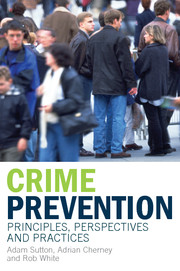4 - Environmental prevention
from PART 1 - THEORY
Summary
Introduction
This chapter will discuss the following topics:
the theory and practice of situational crime prevention (SCP);
thinking innovatively about crime reduction;
crime prevention through environmental design (CPTED);
CPTED theorists and concepts;
CPTED in practice; and
SCP and CPTED as part of inclusive crime prevention.
Theorising relationships between crime and the physical environments in which it occurs has a long history (Taylor and Gottfredson 1986; Skogan 1990). In recent decades Wilson and Kelling's (1982) so-called ‘broken windows’ thesis has been particularly influential. Their argument is that people constantly monitor spaces they move through for signs that order is being preserved. Lack of order-maintenance (e.g. failure to replace broken windows, repair vandalism and remove graffiti) will be read as evidence of community breakdown, and increase the likelihood that people avoid these areas. Potential offenders, however, may see the same physical symptoms as indicators of a lack of guardianship and conclude that the location offers ample opportunities for crime. Research on ‘crime hot spots’ or ‘crimes of place’ also suggests that features of certain locations can make them, and those who frequent them, more vulnerable to crime (Eck and Weisburd 1995).
Environmental theory goes beyond the broken windows and hot spot approaches, however. Theorists and practitioners can be grouped into two broad schools. The first is concerned with practice in fields such as urban planning and architectural design and maintenance, and has attracted the label ‘crime prevention through environmental design’ (generally shortened to CPTED).
- Type
- Chapter
- Information
- Crime PreventionPrinciples, Perspectives and Practices, pp. 48 - 69Publisher: Cambridge University PressPrint publication year: 2008



